|
|
Joe in The Cerrillos Hills. |
|
Joe Blonger spent over a decade prospecting in the
desert hills near Cerrillos, New Mexico.

In preparation for our 2005 trip to New Mexico, we were inquiring about the availability of mining records, and were put in touch with one Bill Baxter, who, evidently, has more factual information about Joe Blonger than we do — records of his activities in the mines of New Mexico, mostly.
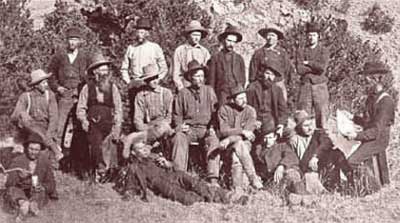
WOLA 2005: Joe in the Cerrillos Hills
Our first engagement upon arrival in New Mexico was to meet with Bill Baxter to learn about the hills where Joe spent many years prospecting and mining. If there is anyone who knows more about this area and the people who lived there, he just may know too much.
The first thing Bill did was hand us a map of all Joe's claims, and a printout detailing the claims he worked and other information about his time there.
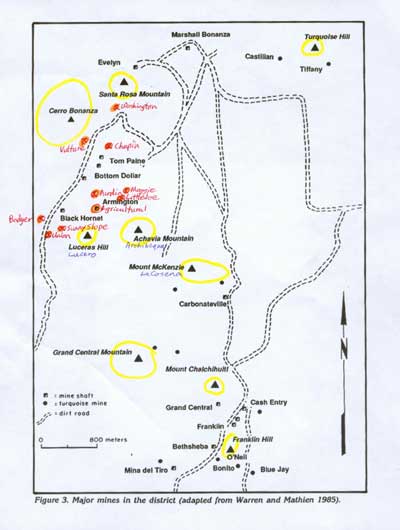
Here's Bill pointing toward Bonanza Hill, where Joe spent some ten years mining.
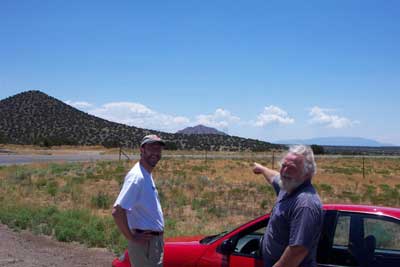
Joe was one of some 1000 miners who descended on the area around 1879, wresting control from the Spanish landowners through sheer force of numbers. Joe may have made his way there after failing in the Black Hills, though this is undocumented.
The Cerrillos Hills are a cluster of small mountains that represent the remanants of a 30 million year old volcano. Indians were quarrying turquoise here as early as 700 AD. Then came the Spaniards, and finally the Anglos in 1879 who came in search of gold and silver, the white man's turquoise...
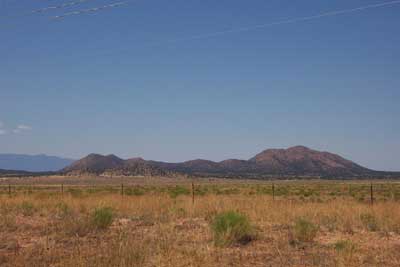
I am here, fortunately, to tell you that it is indeed hot as hell in them thar hills in mid-July. We scouted the area for a couple of hours, and it's a darn good thing Bill brought water for us to carry in, or your humble correspondent might currently be slowly mummifying in the New Mexico sun.
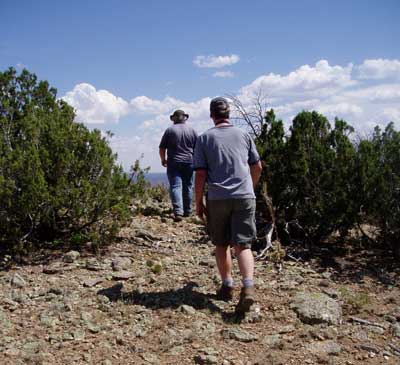
This is Carbonateville, which was for a short time one of the largest towns in New Mexico. Joe would certainly have come here for supplies, recreation and companionship. The road is the old Highway 10.
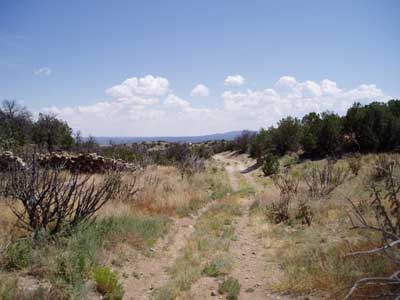
About all that's left now are the walls of the hotel, and a well up the hill that never hit water.
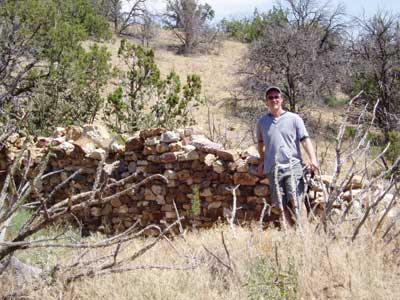
This is a typical mine in these parts, just a hole that goes eighty some feet straight down.
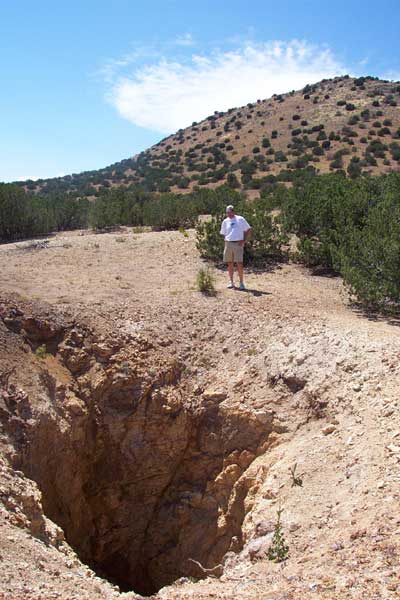
There were around 5000 holes dug in these hills, and Joe worked a number of them. In his early years there, he had some stake in the mines he worked. He disappears from the records about the time Sam and Lou are in Albuquerque, then returns. We really have no evidence he was in Albuquerque aside from a visit in March of 1882, but who knows?
In later years, Joe seemed to be working for others. Why the change? Did he just find himself craving a day's wage? A claim holder had to dig ten feet in a given year to hold a given claim. Often mines would stand unworked till the end of the year, and then a flurry of activity would assure the claims would be valid for another year. Joe often appears on documents in the late Eighties as a witness to the required digging.
Long before the "Colorado Miners," the Indians worked these hills for valuable turquoise, and the area was perhaps the continent's premier source for centuries. You can see that this distant hill is scarred on one side.
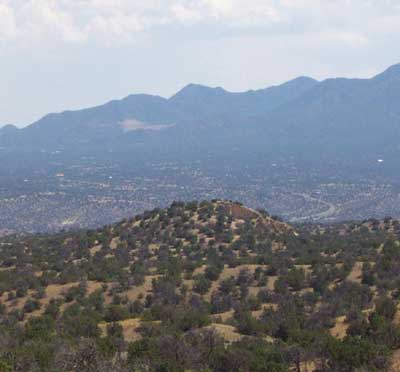
Over hundreds of years the local tribes excavated the entire hillside in search of the stone. Here we are at the base of the excavated hillside. It's thought the Pueblos dug some 100,000 tons of rock here.
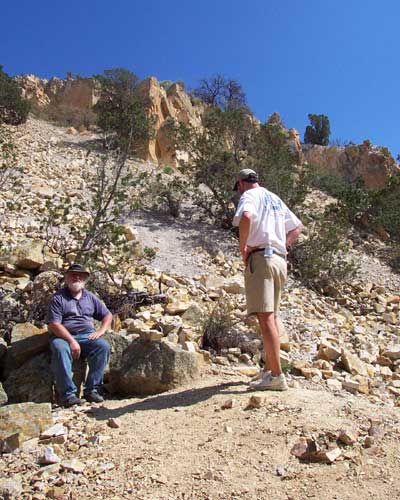
Here's a turquoise mine being worked currently.
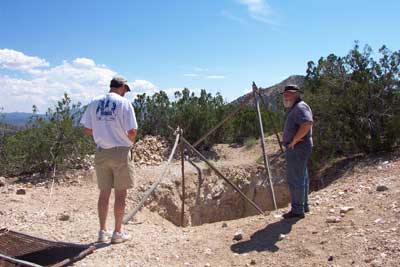
Bill says that most of these mines were dug in search of silver, but turned into gold mines when it came time to sell. The vast majority were worthless claims. Some mines were later worked for galena, lead, zinc.
The Cerrillos boom only lasted about five years, but Joe remained in the area much longer. A marriage license we found in Santa Fe has Joe, at the age of 54, marrying widow Carrie Viles in 1902. We had thought her name to be Clara Biles as stated on Joe's military pension survey, which also stated that Carrie's maiden name was Windsor. Census data indicates she was from Vermont, Joe's birthplace.
We recently received some additional materials from Bill Baxter, photocopied pages from The Cerrillos Mines and Their Mineral Resources. A Description of the Mines in the Los Cerrillos and Galisteo Mining Districts, Accompanied by a Map of the Same, Drawn from Actual Surveys., J. Lyman Hayward, 1880. Included are the pages that mention Joe and the claims he owned or worked, but as the book was published in '80, Joe and his fellow white miners had only been there about a year, give or take, so the data Bill supplied previously is more complete.
What's more interesting is what the book says about this mining area in New Mexico, and further, what Bill says about what the book says.
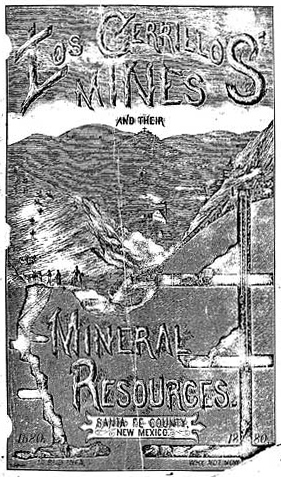
Hayward describes the area, noting that from a distance they resemble a cluster of anthills on the plain south of Santa Fe. And so they do.

He also notes that the hills had been mined for centuries — by the Pueblo for tourquoise, and later the Spanish. When the native population revolted against the Spanish in 1680, many of the mines were filled and hidden to keep them from the Spanish.
Indeed, one of our first finds was an article describing the old stone tools found by Joe and his partner Whalen at the bottom of the Bottom Dollar mine.
Hayward describes the rock slide that occured at the Chalchuitl tourquoise mine, killing some twenty-five indian workers in 1680. The Spaniards attempted to press more workers into service at a local town, but the locals revolted, driving the Spanish from the area for a time.
In naming the various camps of the district — Dimick's Camp, Poverty Hollow, Bonanza City, Cerrillos Station — one name stands out: Purdin's Camp.
Joe was partner with, I assume, this same Purdin in the Agricultural, the Badger, Little Joe, Purdin, Sunny Slope, Union, Vulture and Washington, at least.
And why, according to Hayward, had the Cerrillos area been of no interest to the American capitalist until now?
The answer is simple: New Mexico is populated by a race whom we have been taught to look upon as robbers, and in fact all that is bad. A prospector would naturally look for new discoveries in a country which is not very thickly peopled, consequently the more northern states and territories have been more extensively prospected. The Indians have been troublesome for many years in the territory, and reports (oftentimes greatly exaggerated) of the dangers to which life and property are exposed, have been circulated in many newspapers, thus deterring many from visiting the territory. Then again the remoteness from all communication with the East has been a drawback. Today the real and fancied objections have been removed. The natives of New Mexico are of a kind and generous disposition. They never molest or interfere with a person or his business. Naturally they are inclined to be indolent, yet they are willing to work when employed.
The Indian question is practically settled. As the country becomes more civilized they will not dare to roam openly over the property of others...
And speaking of the Bottom Dollar — the oldest New Mexico heartland mine on which there is documentation (1709, under its earlier name of Santa Rosa):
Santa Fe New Mexican, August 25, 1897
ALEXANDER ALLAN KILLED
Last Evening at Dusk Joseph Blonger Shot and Killed Allan at the Bottom Dollar Mine.
THE TRAGIC RESULT OF A QUARREL
Blonger Surrenders Himself and is Lodged in Jail—The Story of the Tragedy
Last night between 12 and 1 o'clock, Joseph Blonger knocked at Sheriff Kinsell's door and when Mr. Kinsell answered the summons said that he had killed Alex Allan, and surrendered himself to the law.
Mr. Blonger was lodged in jail and about 5 o'clock this morning Mr. Kinsell left for the Bottom Dollar mine, where the tragedy occurred, to get the remains of the dead man.
This forenoon Mr. Blonger was seen in the jail, and to a representative of the NEW MEXICAN told the following story of the killing:
"For over a month past, Alex Allan, Cyrus Smith and myself have worked and camped together at the Bottom Dollar mine. Everything had been pleasant among us, and while Smith and myself were working for Mr. Allan, no contract for any special length of time had been made, we were on good terms and no trouble of any kind had come up. Several days ago Mr. Allan run out of lumber and none could be gotten except from Chicago. Smith and myself wanted to come to Santa Fe until the lumber came, but to this Mr. Allan objected as he would then be left alone. We consented to stay until last Monday. On Saturday Mr. Allan came to Santa Fe and remained until Tuesday morning, when he came back to the mine, reaching there about 10 o'clock."
"Mr. Allan and Smith then walked to Cerrillos to attend to some business and I stayed to watch the camp. They came back just before dark. I had supper ready for them, and we sat down and ate. Just as we had finished Mr. Allan asked me what I was thinking and I told him I was going over to the Bonanza mine to get a team to take me into Santa Fe, and Smith said he would go along. This seemed to anger Allan and he said we were nice fellows to leave him all alone. To this Smith replied: 'We have to look after ourselves and if we want to go away you can't help yourself.' Allan jumped up from the table and drew his gun and covered us with it and said he would see if he could not keep us there. At this time Ed Andrews came up to spend the evening at the camp. Allan lowered the revolver for a moment and then threw it at Smith. It fell near me and I picked it up. Allan clinched with Smith and threw him to the ground. Allan picked up a rock and as he held it over Smith's head said: 'I'll brain you right here.' I don't know how it happened, but I fired at Allan and the bullet struck him either in the chin or just below. Allan sprang up and ran in circles, falling as he ran. In less than five minutes after I shot him he was dead. Before he died, I went to him and told him I was sorry, very sorry that the shooting had happened. He tried to answer me, but his breathing was so difficult and the blood was rushing from the wound so rapidly that I could not understand what he said."
"So soon as I saw he was dead, I got on a horse and went over to the Bandana mine and hitched to a wagon and drove to town, and gave myself up to Sheriff Kinsell. That is all there is to it."
From the manner in which Mr. Blonger tells as to how the killing occurred it is plain to be seen that at the time it happened he was so excited that he did not know what he was doing. He is very despondent over the matter and feels that in defending Smith he has committed a crime he can never atone for. It is certainly a sad case. It all happened in a moment of time, and in the excitement Mr. Blonger lost his judgment and reasoning powers.
This morning, about 11:30, Sheriff Kinsell arrived in the city with the remains of the dead man, which were immediately taken to Gable's undertaking rooms and prepared for burial. A view of the body disclosed the fact that two shots were fired at Mr. Allan in the excitement of the moment by Mr. Blonger, both of them taking effect. One ball struck just at the left corner of the mouth, cutting out all the upper teeth, the other hit the point of the right shoulder and ranged upward and passed through the neck, cutting the juggler vein.
Alex. Allan was well known in Santa Fe and up to a short time ago was deputy sheriff under Sheriff Kinsell, proving himself an efficient officer. About six weeks ago he left that position to work the Bottom Dollar mine in southern Santa Fe county, and was making good progress in developing the property when the unfortunate and deplorable affair of last night happened. He leaves a wife and one child to mourn his death.
Joseph Blonger, now in jail to await a hearing on the charge of murder, is a resident of the city, and is well and favorably known by many of the citizens. He enlisted in Company H, Twenty-fifth Michigan infantry, as a private in March, 1862, and served through the war, and was mustered out of the service on June 5, 1865, as a corporal. He joined Carleton post, G. A. R., of Santa Fe, August 15, 1889, and is still a member in good standing.
After a short trial, the jury was instructed to return a verdict of not guilty, and Joe was free to go.
Here's a detail map of the central Cerrillos Hills mining area. The Santa Rosa — known as the Bottom Dollar — is near the middle.
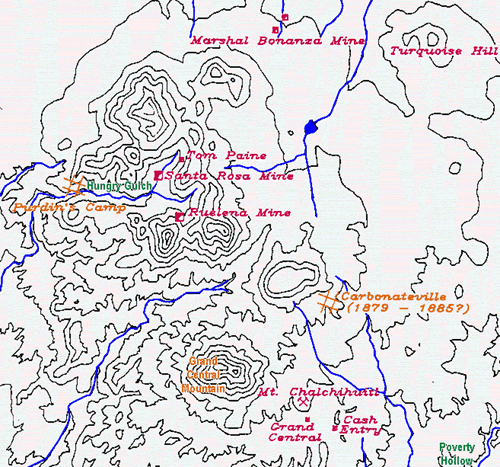
Purdin's Camp is named for Joe's one-time partner. Joe walked to the Bonanza for transportation to Santa Fe to turn himself in.
Cerrillos mining expert Bill Baxter is wondering about those who ponied up bail for Joe after he was charged with the murder of Alex Allan:
I believe some additions to the Grafters Club may be in order, including Joe's longtime partner C.M. Purdin, partner John Andrews, would-be pol Charles A. Scheurich, and J.H. Blain, the ghost miner.
A couple of interesting things here: this our third parachute jumper — there's also Park Van Tassel and his amazon wife Jenny. It's also nice to see our old buddy Tony Neis, who in 1882 persuaded Sam and Lou to join the Rocky Mountain Detective Association in Albuquqerque.
|



